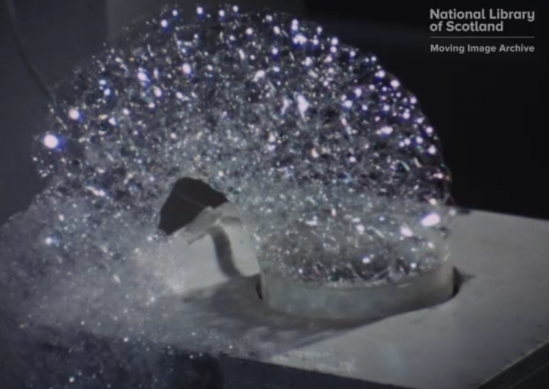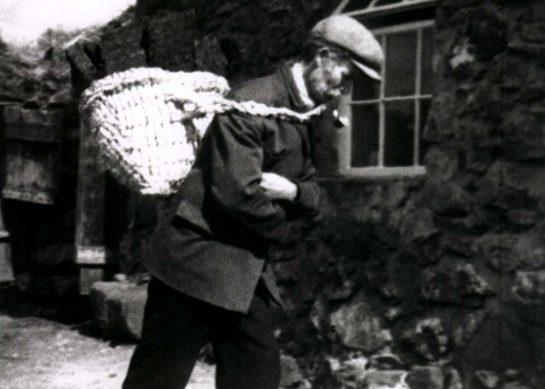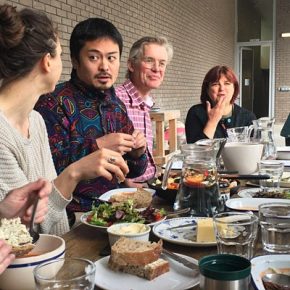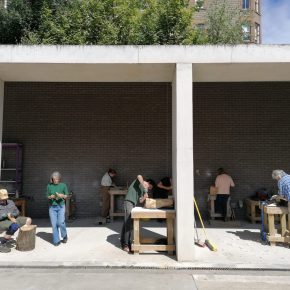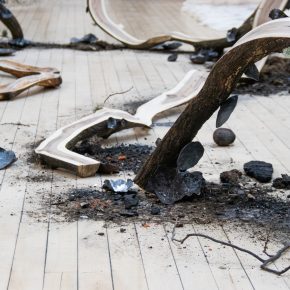Moving Sculpture, Episode #10: Anthea Hamilton
Moving Sculpture introduces links to ESW archives and other diverse online resources that give an insight into the ideas, processes, politics and history of sculpture. In the first month this will include interviews with artists we have worked with, footage of legendary 20th century sculptors and documentation of making techniques, relevant to contemporary practice.
This regular series is an exploration of free to watch documentaries, artists’ films and other moving image resources relating to sculpture and sculptor’s lives.
Moving Sculpture, Episode #10: Anthea Hamilton
The Squash, Tate Britain, Anthea Hamilton Interview
2018, 3.05 mins, sound
Kettle’s Yard Reimagined, Anthea Hamilton Interview
2016, 6.18 mins, sound
This week’s recommendation is a double shot of reflection by Anthea Hamilton. In the first video she speaks about her exhibition The Squash, which was presented at Tate Britain in 2018. In the second video, Hamilton talks about her materials, influences and collaborations in connection to her practice and specifically her exhibition at Kettle’s Yard Reimagined: Anthea Hamilton, which opened at The Hepworth Wakefield in 2016.
Both projects involve artwork by other artists. Hamilton describes those within the tiled installation at Tate Britain as “the ones which would satisfy the hand, to touch, maybe more than the eye… mostly body sized” and goes on to talk about creating the installation as architecture for the body.
You can read more about the making of The Squash, including some of the references for the performers’ costumes here. The ‘making of’ page, also has photographs of all of the sculptures that Hamilton selected to include in the installation, including the life size figurative sculpture Earth (1962) by Jean Robert Ipoustéguy.
In the second video Hamilton speaks about the process of distillation and extraction that was prompted by her experience in the house at Kettle’s Yard (the former home of Jim and Helen Ede who gathered a collection of modernist artwork and objects within their domestic spaces).
In this time of safety restrictions around COVID-19, Tate Britain and Kettle’s Yard are currently closed, and the Walker Art Gallery in Minnesota, which was about to launch a large scale group exhibition about object and movement in art, including Hamilton’s work, is also closed but you can read about the show here.
Image: Anthea Hamilton, The Squash, Tate (Seraphina Neville), 2018
Moving Sculpture, Episode #9: Art and Movement
International Exhibition held at RSA and Kelvingrove Museum, 1965
1965, 9.34 mins, sound
Our next recommendation is a film tracing the introduction of movement as a factor in 20th century art. It was filmed in the international exhibition Art and Movement which was presented in 1965 at the Royal Scottish Academy (6 – 28 February) and at Kelvingrove Art Gallery and Museum in Glasgow (8 – 28 March). The exhibition set out to records various ways in which artists have approached movement within their practice. The film gives a chance to see transient works from the exhibition such as David Medalla’s Cloud Canyons (pictured above) and proposes movement as the unique 20th century contribution to art.
The film, originally shot in 16mm, was devised by William Buchanan and produced by Campbell Harper Films for Educational Films of Scotland and the Scottish Committee of the Arts Council, who had also commissioned the exhibition. It’s held now and presented online by the Moving Image Archive of the National Library of Scotland.
The works shown in the piece are by Naum Gabo, J. R. Soto, Cruz-Diez, Yaacov Agam, Alexander Calder, Marta Pan, Takis, Marcello Salvadori and Harry Kramer, Kenneth Martin, David Medalla and Frank J. Malina. Also included in the exhibition were works by Yaacov Agam, Roy Ascot, Antonio Asis, Pol Bury, Sergio de Camargo, Lygia Clark, Cruz-Diez, Lucio Fontana, Alberto Guzman, Gyula Kosice, Julio le Parc, Liliane Lijn, Otto Piene, Keith Potts and Victor Vasarely which are sadly not shown in the film. Lygia Clark exhibited two Collapsable Sculpture (both 1963) an example of which can be seen in this Apollo article. Lilian Lijn exhibited Acid Painting (1963), Light Work (1964) and Poem Machine (1964); examples of work from this period can be seen on Lijn’s website. The exhibition was part of an intensive moment of shows and articles in the mid 1960s discussing kinetic, mechanical artworks and also introducing other practical and conceptual elements of time, energy, performance, process movement elements of artwork internationally, championed by critics and curators including Guy Brett and Peter Selz.
This particular exhibition, Art and Movement, set out to trace the development of an interest in ‘implied and actual movement’ from 1920 onwards.
The catalogue, which you can see on the Royal Scottish Academy website, has an op art moving cover, designed by Albert Brebner. In his introduction John Rothenstein makes the point that movement and visual art have always been interlinked and goes on to connect the works in the show with other, earlier 20th century activity and contemporary exhibitions, giving a list of those, including Documenta III, the Royal College of Art and several in commercial galleries in Paris, Zurich, Amsterdam, Stockholm and London. Guy Brett’s writing within the catalogue moves through key influences to the work exhibited and describes both ‘environmental integration’ and a particular understanding of ‘Realism’ in respect to the artists’ approaches.
Thanks to everyone at the RSA for sharing images of the catalogue online.
Image: Cloud Canyons, David Medalla, still from film Art and Movement.
Moving Sculpture, Episode #8: Ruth Asawa
Black Mountain College film by Craft in America, PBS
2018, 9.25 mins, sound
This week one of our audience members attached a sign of hope through education to the railings at ESW as a personal support to the Black Lives Matter protests happening around the world. This was poignant for us as an organisation used to having our doors open to all for making and discussion day to day, but which is currently closed, our team in hiatus because of the COVID-19 pandemic. It was also heartening and motivating; a reminder of the many influences which spur us on to invest our time in equalitarian learning experiences and how there is so much more to be done to bring about change. The staff team have learned from and been inspired by many artists and teachers, Ruth Asawa, and her work starting from Black Mountain College, being one of them.
This documentary made by Craft in America talks about the founding of Black Mountain College, an experimental liberal arts college in North Carolina established in 1933. This video speaks about the high profile and, at times, infamous, faculty and gives an insight into sculptor Ruth Asawa’s approach from her time studying and throughout her life. The documentation of that time shows the merging of art and life, with the commentator, Helen Molesworth, describing that Asawa integrated her making, collaboration and child care within the studio environment. Her suspended, crochet wire sculptures bring together organic shapes, bodily references and mathematical precision; a fluidity which refers back to dance and movement. After studying at Black Mountain College, between 1946 and 1949, Asawa established the first art programme in the San Francisco public school system. The aims of the programme were to build the skills to be a curious and cogent human being; to make choices and feed into democracy.
Ruth Aiko Asawa (1926 – 2013) was an American sculptor, educator and arts activist. She made several public artworks including fountains at Ghirardelli Square, San Francisco, in 1968. The same year she co-founded the Alvarada Arts Workshop with architectural historian Sally Woodbridge, a $50 grant and a plan to be open to all San Francisco children regardless of neighbourhood or income level.
Asawa’s own website has photographs of her work and videos of her taking about her processes over time, including commitment to being led by simple, reuseable materials. There’s a useful Google Arts & Culture slide show here too created by the De Young Museum.
Image: © Imogen Cunningham Trust (@imogen.cunningham.trust)
Artwork © Estate of Ruth Asawa
Moving Sculpture, Episode #7: Caroline Achaintre
Baltic Bites interview with Caroline Achaintre
2016, 8.08 mins, sound
Our next recommendation is a video of artist Caroline Achaintre talking about her approaches to two and three dimensional work, filmed on the occasion of her 2016 solo exhibition at BALTIC in Gateshead. A few years later, in 2019, ESW worked with Achaintre on a new commission for our Courtyard and North Lab exhibition space, which was presented as part of Edinburgh Art Festival.
In the BALTIC video, Achaintre introduces some of her small works on paper including ink paintings, some effectively two drawings in one, with layered linear wax resist and coloured washes, and linocut prints, as well as talking about the anthropomorphic nature of some of those images, in common with larger three dimensional work. She speaks about how her work is often both abstract and figurative at the same time. There’s also a short sequence where Achaintre demonstrates the technique she used for her tufted rug sculptures. These soft, textile works were the basis for a new method that Achaintre developed for the commission at ESW. On a much larger scale, she worked with hand knotted raffia to create the shaggy, shifting surface of the final enigmatic work, Echo Peel, a free standing sculpture, which is her first major work for outside. You can see images of Achaintre’s ESW exhibition Encounter L. on our website including close up details and installation shots of Echo Peel and the suite of ceramic works that she presented. We have included some work in progress images within the selection. There’s also an interview with Achaintre, which expands on more of her motivations and ideas within the work for ESW.
You can see more images of Achaintre’s work on her website and on Arcade’s website which also has an illustrated essay about her work written by Charlotte Cosson and Emmanuelle Luciani.
Caroline Achaintre was born in France and raised in Germany, she now lives in London. She studied at Kunsthochschule in Halle/Saale, Germany and then at Chelsea College of Art & Design and Goldsmiths College, both London. Recent solo exhibitions include Permanent Wave, Belvedere 21, Vienna (2019); BALTIC Centre for Contemporary Art Gateshead (2016); and Fantômas, De La Warr Pavilion (2018). Her work was included in British Art Show 8, Hayward Touring, which was presented in Leeds, Edinburgh, Norwich and Southampton (2016-17).
This BALTIC Bites video is one of many excellent introductions to artist’s work featured on their Youtube and Vimeo channels alongside exhibition tours and documentation of events.
Image: BALTIC Bites video of Caroline Achaintre, 2016.
Moving Sculpture, Episode #5: Janine Antoni
SculptureCenter interview with Janine Antoni
2009, 3.36 mins, sound
This week’s recommendation is a video of artist Janine Antoni speaking about her approach to sculpture. The video was created in 2009 as part of SculptureCenter’s Framing Sculpture series and is available on their YouTube channel.
Janine Antoni’s work often utilises her own body and everyday activities such as bathing, eating and sleeping as sculptural processes. In the video she shows her conviction and curiosity about her own making experience saying that her process gets exciting when the evolving object gains agency and “starts to make me”.
Janine Antoni was born in the Bahamas and now lives in New York. Her work has been shown internationally including at major biennials and festivals including documenta14, Kassel, the Venice Biennale, the Whitney Biennial, the Johannesburg Biennial, the Istanbul Biennial and the Kwangju Biennial. Her work is included in many collections worldwide and she has been the recipient of several awards and fellowships including The John Simon Guggenheim Memorial Foundation Fellowship in 2011 and Anonymous Was A Woman Grant in 2014. You can see her work Tangent showing as part of online exhibition The Artist and The Self at James Fuentes Gallery and there is a photo review in It’s Liquid showing Antoni’s sculptures and photography work as part of a large-scale group exhibition Amuse Bouche at Museum Tinguely in Switzerland which considers the role which the sense of taste has in our social interactions.
ESW team are always looking at other organisations’ approaches and ways of working with artists and several staff members have visited SculptureCenter in the past, with Laura Simpson visiting during a trip to North America and Canada in February 2020 when she met the new Director Christian Rattemeyer and Curator Sohrab Mohebbi. Find out more about their current programme online, including their latest show with Rafael Domenech and a fantastic set of resources relating to the show which was due to open this month by Tishan Hsu. Like ESW, SculptureCenter is offering support to artists in writing bids for funding and they also have an open call for In Practice, which closes on 15 June 2020.
Image: Still from Framing Sculpture: Janine Antoni, SculptureCenter, 2009.
Moving Sculpture, Episode #4: Kenny Hunter
Reproductive! interview with Kenny Hunter
2016, 3.5 mins, sound
Our next recommendation is an interview that explores some of the ideas within Kenny Hunter’s Reproductive! exhibition at Edinburgh Sculpture Workshop in 2016. Hunter talks about his interest in the conflicts within monumental sculpture and his own personal relationship to that as he has developed his work over time. He speaks about how ideas of collective memory are influential within his practice and how making gallery exhibitions differs from working in the public realm. A key element of his work comes from reflecting on an obsession with the original and authentic. Within the exhibition there were works that dealt with copying or reproducing in several ways. One prone sculpture of a human skeleton is utilising a part of the process from another work, The Unknown, which was installed in Borgie Forest in 2012, supported by Forestry Commission Scotland. The large potato sculptures are modelled ‘from life’ despite their super scale, lavishing attention and status onto an object which would not usually be considered monumental or worthy of reproduction, despite it’s own ability as a tuber to self-propagate. Hunter chose the title Reproductive! as an active, and certainly more positive, interpretation of the word, indicating the creativity and abundance which can be held within the act of copying. The project used both traditional sculpture and contemporary digital production techniques with events which further diluted the idea of the original by opening up to others to enter into processes of remaking.
You can read more about the exhibition and Kenny Hunter’s work in this gallery booklet which includes an essay by Dan Brown and an extended interview he conducted with Hunter. The writing includes a range of socially charged references to fakes, facsimiles, versions, iterations, casts, copies, mimesis and blueprints which are intrinsically connected to sculpture practice.
If you would like to see more of Kenny Hunter’s work, the National Galleries of Scotland made this video with him in 2015.
Hunter’s recent public artworks include The Southwark Memorial to war and reconciliation, London, (2018) and A place is space remembered, Maison du Site des Deux-Caps, France, (2015). Over the last 15 years he has exhibited extensively, including at Esbjerg Kunstmuseum, Denmark (2013); Busan Biennale Sculpture Project, Korea (2013); Timespan, Helmsdale, (2012) in an exhibition related to The Unknown commission; Tramway, Glasgow, (2008); and Yorkshire Sculpture Park, Wakefield, (2006). He is the Director of Outreach at Edinburgh College of Art.
Image: Kenny Hunter, Two Identical Forms, part of Reproduce!, 2016. Photo: Graeme Yule.
Moving Sculpture, Episode #3: Da Makkin O’ A Keshie
Da Makkin O’ A Keshie, by Jenny Brown
1932, 5.15 mins, silent
This week we are sharing a film of a very particular making technique demonstrated by a Shetland crofter in the 1930s and captured by Jenny Brown (later named Jenny Gilbertson) then bought by the pioneering Post Office GPO film unit.
The crofter, called Gideon in the library record but actually it is John Gilbertson who would later become Jenny Brown’s father in law, demonstrates how he makes an essential carrying basket for himself from his own crops. He uses a type of basketry knotting, using skeins of threshed corn, check out the hooked necklace, which is an essential part of the process. He’s using the process to create practical tool, paying attention to the aesthetics and to visual queues about the balance, strength, symmetry and flexibility of the structure. This knotting, weaving and binding are the same processes which many artists have used when adapting those types of techniques for making sculpture; whether it be to pursue the same strength and symmetry or to break down and redirect the physical manipulation of materials into another meaning. On the cycle path next to ESW you can see Lucy Wayman’s rope work Clovehitch installed. You can read more about Clovehitch, which was a new commission supported by Sustrans and launched during Edinburgh Art festival, on our website.
You can read more about Jenny Gilbertson’s work in this edition of The Drouth written by Jenny Brownrigg and on Shona Main’s website page about Jenny Gilbertson.
Da Makkin O’ a Keshie is part of a much larger body of work, where Gilbertson documented the cyclical nature of life in Shetland. She worked alone and built a special rapport with the individuals she filmed. She covered the town and country life of the islands, giving insight into the work of the men and women, equally balancing the importance of each one’s efforts, a technique which she carried onto one of her next works Prairie Winter (1935), a collaboration with Evelyn Spice, filmed in Saskatchewan.
Image: Da Makkin o’ a Keshie, Jenny Brown (Gilbertson), National Library of Scotland (cropped still).
Moving Sculpture, Episode #2: Barbara Hepworth
1953, 17 mins, musical score and voiceover
This week’s recommendation is a poetic portrait of sculptor Barbara Hepworth and the otherworldly Cornish landscapes which inspired her. The film was commissioned by the British Film Institute’s Experimental Film Fund and can be viewed on BFIPlayer.
This documentary is a time-piece which shows Hepworth in her element; sculptor, work and environment in synchrony at a pivotal point in her life, just after she had designed the sculptures for the Festival of Britain and running up to key festival showings in Edinburgh, Venice and St Ives in 1953. Hepworth is one of the UK’s best known sculptors, involved in the evolution of sculpture in the middle of the 20th century, a proponent of direct carving and a central point within a group of UK and international artists. Her legacy of approach and aesthetic is still seen within contemporary artists work and her work is held within many public collections (you can browse her work on ArtUK), including the Hepworth Wakefield, which opened in 2011 in her home town. You can also see Hepworth’s home and studio in St Ives through this TateShots film.
This film came up in ESW’s activity last year, as a reference within Laura Simpson’s paper on sculpture workshops and studio communities for the Scottish Society for Art History Study Day and within the introductory presentation, which Birthe Jorgensen used for our Wood Carving evening class.
Figures in a Landscape was made by Dudley Shaw Ashton. The film includes an extraordinary score by Priaulx Rainier, a composer who had joined the artist community in St Ives. The composer and artist were both working through abstraction, leading new advances in Modernism and had a sustained connection over the following two decades. You can read more about Priaulx Rainer’s work on MusicWeb International, listen to some of her music here, and get some insight into the development of her modernist oeuvre through understanding more about her teacher Nadia Boulanger.
Image: Still from Figures in a Landscape, BFI.
Moving Sculpture, Episode #1: Adam Benmakhlouf
The Noise of Making Spills Over Introduction Video on ESW’s Youtube Channel
2019, 58 secs, sound
Our first recommendation is Adam Benmakhlouf’s video introduction to his audio work The Noise of Making Spills Over, which was commissioned by ESW as part of Edinburgh Art Festival in 2019. You can also listen to the work itself on this page, which has more information about Benmakhlouf’s project.
Benmakhlouf’s work often has elements of autobiography, either snippets of their own personal life or of interactions they experience within the making of their projects. The commission at ESW was Benmakhlouf’s first time exclusively using sound; they also work in drawing, painting, video and writing. For The Noise of Making Spills Over they gathered hours of recordings within the Schools Programme sessions which they assisted on at ESW – making artworks with Trinity and Victoria Primary Schools P5 pupils – and in many other situations, seeking out similarly experimental and supportive environments where adults could enter into a unselfconscious creativity and performance.
Benmakhlouf is working on several projects over the next year, including an exhibition at CCA’s Intermedia Gallery. They also work as a journalist for The Skinny and have collaborated on a new podcast which is called Breaking Up.

